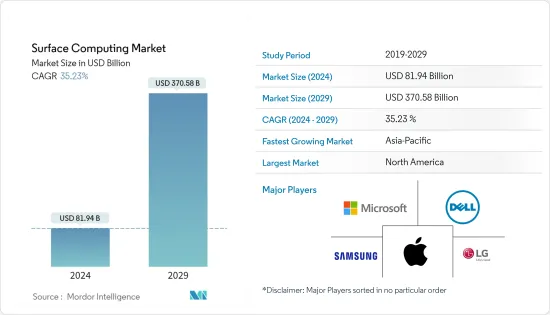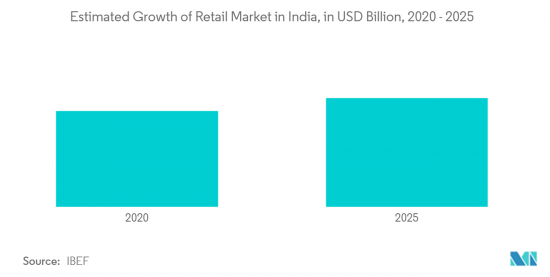 |
市場調查報告書
商品編碼
1403078
表面計算:市場佔有率分析、產業趨勢/統計、成長預測,2024-2029 年Surface Computing - Market Share Analysis, Industry Trends & Statistics, Growth Forecasts 2024 - 2029 |
||||||
※ 本網頁內容可能與最新版本有所差異。詳細情況請與我們聯繫。
表面計算市場規模預計到 2024 年為 819.4 億美元,預計到 2029 年將達到 3705.8 億美元,在預測期內(2024-2029 年)複合年成長率為 35.23%。

主要亮點
- 表面計算是一種新的計算型態,可讓您將桌面表面作為電腦介面進行工作。表面計算使用專用的電腦 GUI,因為傳統的 GUI 被直覺的物件所取代。表面運算開啟了使用者可以互動的全新產品類別。
- 微軟是第一家引進表面運算概念的公司。 Microsoft Surface 技術允許將非數位物件用作輸入裝置。 Microsoft Surface 是 Microsoft 推出的首款商用表面電腦,它是一個革命性的表面計算平台,可響應自然手勢以及現實世界物件在顯示器上的放置。 Microsoft Surface 使用大型 360 度水平使用者介面來創建一個獨特的聚集場所,多個使用者可以同時協作並與資訊和內容互動。使用者還可以透過在螢幕上觸摸和拖曳指尖或畫筆等對象,以及定位和移動放置的對象來與機器互動。
- 此外,商用多點觸控技術(例如 Microsoft 和 SMART Technologies 的技術)使表面運算能夠在實驗室以外的場所使用,例如企業、零售店、酒店、學校、餐廳甚至醫院。預計將成為預測期內市場成長的驅動力。此外,微軟Surface具有獨特的功能,可讓企業設計創新宣傳活動來獲取和轉化新客戶、交叉銷售產品和服務、提高客戶忠誠度並提高業務效率。
- COVID-19大流行的一個積極方面是技術的使用增加。 PC市場是少數幾個需求大幅成長的市場之一,因為由於各種限制以及大多數企業組織採用的遠距工作模式,人們大多被限制在家中。由於混合工作模式預計將在 COVID-19 後持續存在,個人電腦及相關行業可能會出現持續的需求。
- 介面設計的複雜性和多向媒體是重要的市場議題。由於可用功能較少且普及較高,預計 Surface 電腦的採用將受到限制。由於行業內的激烈競爭,表面計算市場遇到了重大障礙,導致參與者採用多用戶和表面計算技術。
表面計算市場趨勢
零售業預計將佔據主要市場佔有率
- 零售業對錶面計算市場的成長具有巨大潛力。表面運算不僅使交易變得更快、更輕鬆,還為企業主提供了個人化的運算環境。表面運算還可以幫助公司透過減少紙張、墨水和其他辦公用品的浪費來促進綠色措施。
- 透過將實體店與數位體驗連接起來,零售商可以更好地服務客戶,並創建從銷售樓層和商店到最高管理層的更互聯的組織。線下商家正在擁抱新的商業模式,例如非接觸式購物和路邊取貨。這是一個巨大的轉變,將幫助消費者找到他們想要的東西,預測需求,並為零售商在競爭的市場中創造新的機會。
- 同樣,根據印度零售商協會(RAI) 的數據,2021 年2 月,零售業實現了COVID-19 之前銷售額的93%,而耐用消費品和快餐店(QSR) 分別實現了15% 和18% 的成長。
- 此外,2023年5月,中國超級市場麥德龍推出了名為「Telpo」的自助服務終端。 K7 Telpo Kiosk 有多種付款方式,包括電子轉帳、2D碼和臉部認證。熱敏印表機紙張寬度為80毫米,列印速度為每秒150毫米,並配有自動切割機。
- 此外,零售業的數位化正在突飛猛進。表面運算技術可以透過多種方式進一步支援零售業的轉型,包括高效的庫存管理、改善的用戶體驗、增強的盈利以及擴大的廣告機會。

預計北美將佔據最大的市場佔有率
- 北美是一個已開發地區,其購買力和可支配收入高於發展中地區。在北美,市場以美國為主導,表面計算廠商集中。
- 由於該地區對技術先進產品的需求,北美表面計算市場正在快速發展。消費者的高認知度和產品的便利性正在增加該行業的成長機會。美國是多家重要的表面運算技術製造商的所在地,產品認知度和需求不斷增加。
表面計算行業概述
由於微軟、戴爾、蘋果和三星等現有參與者的存在,表面運算市場競爭適中。然而,隨著表面計算變得越來越普及,參與者之間的競爭預計將加劇。
其他福利:
- Excel 格式的市場預測 (ME) 表
- 3 個月的分析師支持
目錄
第1章簡介
- 研究假設和市場定義
- 調查範圍
第2章調查方法
第3章執行摘要
第4章市場洞察
- 市場概況
- 產業吸引力-波特五力分析
- 新進入者的威脅
- 買方議價能力
- 供應商的議價能力
- 替代品的威脅
- 競爭公司之間敵對關係的強度
- COVID-19 市場影響評估
第5章市場動態
- 市場促進因素
- 更先進和方便用戶使用的介面 - 自然用戶介面(NUI)
- 透過採用多用戶平板電腦增加業務收益
- 市場抑制因素
- 可用功能有限
- 表面電腦高成本
第6章市場區隔
- 類型
- 平面顯示器
- 曲面顯示器
- 成分
- 螢幕
- 相機
- 感應器
- 處理器
- 軟體
- 投影儀
- 其他
- 觸碰
- 單點觸摸
- 多點觸摸
- 多用戶
- 其他
- 想像
- QR 圖
- 3D
- 應用
- 娛樂
- 零售
- 款待
- 衛生保健
- 商業的
- 廣告
- 車
- 教育
- 其他
- 地區
- 北美洲
- 美國
- 加拿大
- 歐洲
- 英國
- 德國
- 法國
- 其他歐洲國家
- 亞太地區
- 中國
- 日本
- 印度
- 其他亞太地區
- 拉丁美洲
- 墨西哥
- 巴西
- 阿根廷
- 其他拉丁美洲
- 中東/非洲
- 沙烏地阿拉伯
- 阿拉伯聯合大公國
- 南非
- 其他中東/非洲
- 北美洲
第7章競爭形勢
- 公司簡介
- Microsoft Corporation
- 3M Co.
- Dell Inc.
- Samsung Electronic Co. Ltd
- Planar Systems Inc.
- Lenovo Group Ltd
- Apple Inc.
- Viewsonic Corporation
- Toshiba Corporation
- Hewlett-Packard Ltd
- Sony Corporation
- LG Electronics Inc.
- Fujitsu Ltd
- IBM Corporation
- Intel Corporation
- Panasonic Corporation
- Qualcomm Technologies Inc.
- Acer Inc.
第8章投資分析
第9章市場的未來

The Surface Computing Market size is estimated at USD 81.94 billion in 2024, and is expected to reach USD 370.58 billion by 2029, growing at a CAGR of 35.23% during the forecast period (2024-2029).
Key Highlights
- Surface computing is a new form of computing that allows users to work on a tabletop surface as a computer interface. Surface computing uses a specialized computer GUI as the traditional GUI is replaced by intuitive objects. Surface computing opens up a whole new category of products for users to interact with.
- Microsoft was the first company to unveil the concept of surface computing. The technology of Microsoft Surface allows non-digital objects to be used as input devices. Microsoft Surface, the first commercially available surface computer from Microsoft, is a revolutionary surface computing platform that responds to natural hand gestures and the placement of real-world objects on display. Using its large, 360-degree, horizontal user interface, Microsoft Surface creates a unique gathering place where multiple users can collaboratively and simultaneously interact with information and content. Furthermore, users can also interact with the machine by touching or dragging their fingertips and objects, such as paintbrushes, across the screen or by placing and moving placed objects.
- Furthermore, commercially available multitouch technology (e.g., Microsoft and SMART Technologies) enables exploration of surface computing in settings outside of the lab, such as of?ces, retail stores, hotels, schools, restaurants, and even hospitals, which is expected to drive the market growth during the forecast period. In addition, Microsoft Surface, with its unique set of features, enables companies to design innovative campaigns to attract and convert new customers as well as cross-sell products and services, drive customer loyalty, and achieve operating efficiencies.
- One of the positive aspects of the COVID-19 pandemic was the increased use of technology. The PC market has been among the few markets wherein the demand has increased significantly as people are mostly staying in due to various restrictions and the remote working model adopted by most corporate organizations. As the hybrid working model is expected to be sustained in the post-COVID-19 period, the PC and related industries are expected to witness a sustainable demand.
- Interface design complexity and Multi-directional media are significant market problems. The low availability of features and the high cost of surface computers are expected to limit their adoption rate. The surface computing market has encountered a significant barrier due to the intense competition in the industry, resulting in players adopting multi-user and surface computer technology.
Surface Computing Market Trends
The Retail Sector is Expected to Hold a Significant Market Share
- The retail segment possesses a huge potential for the growth of the Surface Computing Market. Surface computing not only makes transactions faster and easier but also provides a personalized computing environment to business owners. Surface computing also facilitates businesses in their green initiatives, allowing them to cut back on paper, ink, and other office supply wastes.
- Retailers connect their physical locations with digital experiences to better serve customers and build a more connected organization from the sales/shop floor to the C-suite. Offline merchants are embracing new business models, like contactless shopping and curbside pickup. It's an upheaval that brings new opportunities for retailers in an ever-competitive market, helping consumers find what they're looking for and anticipating demand.
- Similarly, according to the Retailers Association of India (RAI), the retail industry achieved 93% of pre-COVID-19 sales in February 2021; consumer durables and quick service restaurants (QSR) increased by 15% and 18%, respectively.
- Further, in May 2023, Metro, a China-based supermarket, introduced Telpo self-service kiosks. The K7 Telpo kiosks feature multiple payment methods, including EFT, QR code, and facial recognition. The thermal printer features an 80-millimeter paper width, 150-millimeters per second printing speed, and an automated cutter.
- Furthermore, the digitization of the retail sector has increased manifold. Surface computing technology can further support the transformation of the retail sector in multiple ways, including efficient inventory management, better user experience, enhanced profitability, and better advertising opportunities.

North America is Expected to Hold the Largest Market Share
- North America is a developed region, and people have more purchasing power and disposable income than those in growing areas. In North America, this market is driven by the United States, owing to the concentration of surface computing manufacturers.
- The North America surface computing market is developing rapidly due to the region's demand for technically advanced products. High consumer awareness and easy product availability increase the industry's growth opportunities. The existence of several significant surface computing technology manufacturers in the U.S. creates heightened product awareness and demand.
- According to Select USA, the U.S. media and entertainment industry is the largest in the world. At USD 717 billion, it represents a third of the global media and entertainment industry, and it includes motion pictures, television programs and commercials, streaming content, music and audio recordings, broadcast, radio, book publishing, video games, and ancillary services and products.
- Furthermore, the country's retail sector is among the largest, owing to the presence of retail giants such as Amazon and Walmart. According to the U.S. Census Bureau, total retail sales for the 12 months of 2021 were up by 19.3% from 2020, while total sales for October 2021 through December 2021 were up by 17.1% from the same period a year ago.
- The growth of these sectors, along with the growing adoption of innovative technological solutions across various sectors, is expected to drive the development of the surface computing market in the region during the forecast period.
Surface Computing Industry Overview
The surface computing market is moderately competitive due to the presence of established players such as Microsoft, Dell, Apple Inc., and Samsung. However, competition among the players is expected to grow as the penetration of surface computers increases.
In April 2023, Zalando introduced a virtual fitting room pilot to millions of customers. This pilot brings the virtual fitting room to customers in all 25 Zalando markets for the first time. The company has already successfully run two pilots with selected clothing items from Zalando's and Puma private label Anna Field, where more than 30,000 customers have tried this innovative technology.
In August 2022, Hugo Boss ventured into a virtual reality dressing room, letting online shoppers try on apparel using personalized avatars. The exclusive German brand has partnered with virtual try-on (VTO) provider Reactive Reality for the ambition, initially available for UK, German, and France customers. Customers can check on thousands of products via personalized dummies created through Reactive Reality's PITCTOFiT platform.
Additional Benefits:
- The market estimate (ME) sheet in Excel format
- 3 months of analyst support
TABLE OF CONTENTS
1 INTRODUCTION
- 1.1 Study Assumptions and Market Definition
- 1.2 Scope of the Study
2 RESEARCH METHODOLOGY
3 EXECUTIVE SUMMARY
4 MARKET INSIGHTS
- 4.1 Market Overview
- 4.2 Industry Attractiveness - Porter's Five Forces Analysis
- 4.2.1 Threat of New Entrants
- 4.2.2 Bargaining Power of Buyers
- 4.2.3 Bargaining Power of Suppliers
- 4.2.4 Threat of Substitute Products
- 4.2.5 Intensity of Competitive Rivalry
- 4.3 Assessment of the Impact of COVID-19 on the Market
5 MARKET DYNAMICS
- 5.1 Market Drivers
- 5.1.1 More Advanced and User-friendly Interface - Natural User Interface (NUI)
- 5.1.2 Increasing Business Revenue Due to Adoption of Multi-user Tabletops
- 5.2 Market Restraints
- 5.2.1 Limited Availability of Features
- 5.2.2 High Cost of Surface Computers
6 MARKET SEGMENTATION
- 6.1 Type
- 6.1.1 Flat Display
- 6.1.2 Curved Display
- 6.1.3 Components
- 6.1.3.1 Screen
- 6.1.3.2 Camera
- 6.1.3.3 Sensor
- 6.1.3.4 Processor
- 6.1.3.5 Software
- 6.1.3.6 Projector
- 6.1.3.7 Other Components
- 6.2 Touch
- 6.2.1 Single Touch
- 6.2.2 Multi-touch
- 6.2.3 Multi-user
- 6.2.4 Other Touches
- 6.3 Vision
- 6.3.1 Two Dimensional
- 6.3.2 Three Dimensional
- 6.4 Application
- 6.4.1 Entertainment
- 6.4.2 Retail
- 6.4.3 Hospitality
- 6.4.4 Healthcare
- 6.4.5 Commercial
- 6.4.6 Advertisement
- 6.4.7 Automotive
- 6.4.8 Education
- 6.4.9 Other Applications
- 6.5 Geography
- 6.5.1 North America
- 6.5.1.1 United States
- 6.5.1.2 Canada
- 6.5.2 Europe
- 6.5.2.1 United Kingdom
- 6.5.2.2 Germany
- 6.5.2.3 France
- 6.5.2.4 Rest of Europe
- 6.5.3 Asia-Pacific
- 6.5.3.1 China
- 6.5.3.2 Japan
- 6.5.3.3 India
- 6.5.3.4 Rest of Asia-Pacific
- 6.5.4 Latin America
- 6.5.4.1 Mexico
- 6.5.4.2 Brazil
- 6.5.4.3 Argentina
- 6.5.4.4 Rest of Latin America
- 6.5.5 Middle-East and Africa
- 6.5.5.1 Saudi Arabia
- 6.5.5.2 United Arab Emirates
- 6.5.5.3 South Africa
- 6.5.5.4 Rest of Middle-East and Africa
- 6.5.1 North America
7 COMPETITIVE LANDSCAPE
- 7.1 Company Profiles
- 7.1.1 Microsoft Corporation
- 7.1.2 3M Co.
- 7.1.3 Dell Inc.
- 7.1.4 Samsung Electronic Co. Ltd
- 7.1.5 Planar Systems Inc.
- 7.1.6 Lenovo Group Ltd
- 7.1.7 Apple Inc.
- 7.1.8 Viewsonic Corporation
- 7.1.9 Toshiba Corporation
- 7.1.10 Hewlett-Packard Ltd
- 7.1.11 Sony Corporation
- 7.1.12 LG Electronics Inc.
- 7.1.13 Fujitsu Ltd
- 7.1.14 IBM Corporation
- 7.1.15 Intel Corporation
- 7.1.16 Panasonic Corporation
- 7.1.17 Qualcomm Technologies Inc.
- 7.1.18 Acer Inc.










